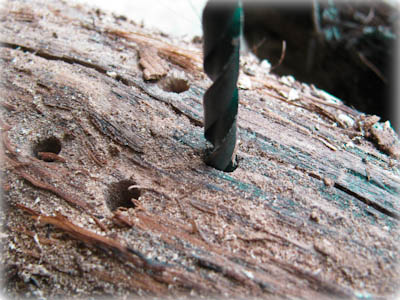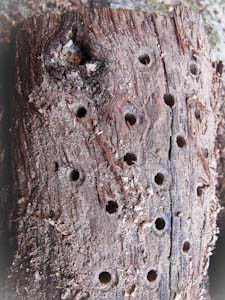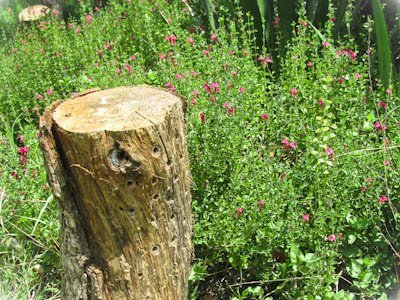Today I finally built some nesting logs for native bees. I got inspired by the frequent postings of Gail Eichelberger about native plants and native polinators on her blog Clay and Limestone. I then used some instructions from the Xerces Society (PDF), grabbed some old oak logs and got to work. Most native bees build solitary nests. Some nest in the ground and others nest in holes in wood or other cavities.
According to the Xerces Society, holes for wood nesting bees should be 3/32″ to 3/8″ wide and at 3-4″ deep for holes less than 1/4″ in diameter. And they should be spaced about 3/4″ apart. Since I had a 3/16″ drill bit on hand, that’s the size that I chose.
The logs before drilling. I peeled off some of the bark so that I could get the holes deeper into the wood. Note that beetles have already made some pathways.
The holes are drilled in the upper portion of the log. The lower portion will be buried to mimic a rotting tree trunk.
I dug three holes in my front yard garden near the pink skullcap. Then I buried the lower portion of the logs deep enough that they would be stable, with the holes facing Southeast. The holes are only in the upper portion of the logs.
I’ll find out over the coming months if any bees decide to take advantage of these logs. As an added bonus, the logs add a decorative element to the garden.





Nice! Can’t wait to hear if you entice some bees to your garden!
I love inspiring folks to provide homes for native bees. I love this project and made one myself, even added a roof! Thank you for the kind linkage and may the wood nesting bees show up soon! gail
Thank you for the information. This is certainly a quick project we could do and add to our garden area.
Wow, I have never heard of this before. I respect our native bees. The bumblebees have been especially kind to us over the years in giving us the best green beans from my heirloom seeds. I haven’t seen as many bumblebees-but lately, they seem to be coming around. I haven’t seen as many yellow jackets out this year, but that’s probably because of so much rain. I am wondering if they were killed from so much rain? Lots of honey and wasps have been out. More than I have seen in a few summers. Many hornets this year. I am in the foothills of NC. Thanks for the idea of bee nesting logs. That might be something to consider. I’ve never thought about giving a home to the bees.
Great idea!